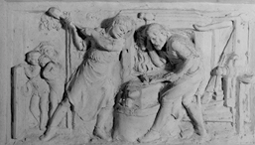The Blacksmith's Forge
Benjamin Creswick (1853-1946). Terracotta relief, 1870s
WorkThis terracotta relief evokes the dignity of labour, an idea at the heart of Ruskin's social philosophy. In The Stones of Venice, he had spoken of the 'fatal error of despising manual labour when governed by intellect' (Works, 10, p. 201). He complained that 'we want one man to be always thinking, and another to be always working [...] whereas the workman ought often to be thinking, and the thinker often to be working'.Creswick's relief pays homage to Ruskin's belief in the ideal union of the intellect and the body. The muscles of the blacksmith expend brute force, but that force is guided by skilful handling of the hammer, and intelligent co-operation with the fellow worker. A productive outcome is suggested by the presence of the children in the background, who gain sustenance by the labour of their parents.A revealing contrast is suggested by Dickens's portrayal of Joe Gargery's forge in Great Expectations. The novel's hero, Pip, resents the confinement of apprenticeship as a blacksmith; only after gaining a fortune and an education does he come to regret his separation from the 'honest' values of the forge.
ArtistThe story of Benjamin Creswick is also the story of the Museum and its founding principles. Cook and Wedderburn pick up the thread:'A young grinder strolled one Saturday afternoon into the Museum. Its contents interested him, and he fell into conversation with the curator. The spark was quickened, and the grinder became a sculptor. He borrowed some photographs of Ruskin from Mr. Swan, and from these he set to work to model a bust. It was doubtless rough and crude, but Ruskin's discerning eyes detected the talent which was struggling to find expression. [... Collection of the Guild of St George, Museums Sheffield
] Ruskin declared the bust, while it was still in progress, "unsurpassed in modern sculpture except by Thorwaldsen". This work was [...] presented to Prince Leopold; a replica of it is in the Ruskin Museum [...] Ruskin's admiration of the artist took a characteristic form. He encourated him to persevere, and put him into a position to do so. In London there are many opportunities of enjoying Mr. Creswick's work. He modelled the head of Carlyle on the tablet of Cheyne Walk. The frieze on the front of the shop of Mr. Henry Heath, the hatter in Oxford Street, is his work, and his too are the set of designs in terra-cotta which decorate the front of Cutlers' Hall, in Warwick Lane, off Newgate Street. The interest and vitality of this latter work are as remarkable as is the beauty of its grouping. As Ruskin would have wished, it takes its motive, not from past conventions, but from the actual life of the forge and the grindstone, as the artist himself knew it. The frieze -- which illustrates successively the processes of smithing, grinding, finishing, and fitting -- is an attempt to show the interest and beauty which may surround the life and work of the skilled English mechanic' (Works, 30, p. xlvi)Creswick eventually became a professional sculptor, and took up the post of model-master at the Birmingham School of Art.
|



















